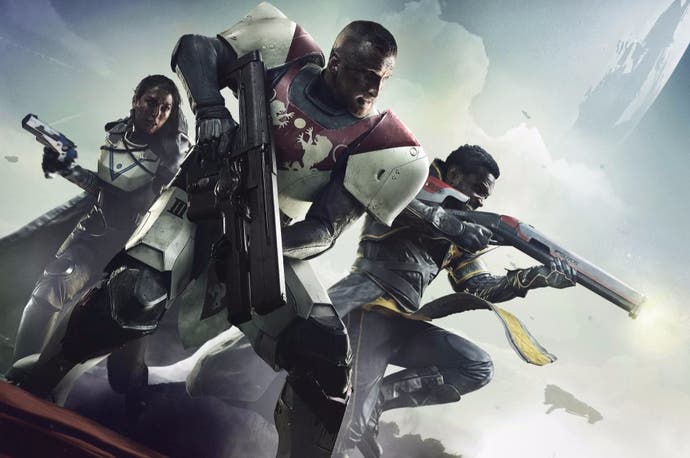Does Xbox One get the full-fat Destiny 2 experience?
And could it hit native 4K on Xbox One X?
Bungie set out to achieve cross-platform parity with the first Destiny three years ago and to a great extent, it fully achieved that: 1080p on both systems, an identical visual feature set and very similar performance levels. The question is, can it repeat the same trick on a technologically more challenging sequel? The Destiny 2 beta content released this week suggests that it can, and it may provide some hints on what to expect from an Xbox One X port.
First impressions of the Xbox One code are promising. Side-by-side shots reveal that the same philosophy that powered the first Destiny is in place here: geometry, draw distance, asset quality, post-processing effects - it's identical across platforms. And that goes for both negatives and positives in Destiny 2's visual make-up: anisotropic filtering is set to a low level on both systems, something that even extends to the PS4 Pro version. The level of parity here is an impressive achievement bearing in mind that Bungie has pushed the boat out technically for the sequel: the effects pipeline is richer and GPU-driven particles are ramped up to the next level, something that's clear from the beta content.
The original Destiny was a cross-gen release - a game designed to straddle two console eras, so perhaps aiming for parity on PS4 and Xbox One made life easier in terms of workflow, but it left us with the sense that there was more left in the tank on the Sony platform. This is borne out to a certain extent by the sequel, where there is one key difference between the two current-gen consoles: resolution. It speaks to the talent of the engineers that you'll struggle to tell the difference during the heat of gameplay, but the evidence suggests that Xbox One is using similar dynamic resolution scaling technology to the PS4 Pro version of the beta (hat tip to VGTech for spotting this first).
The engine scales pixel-count according to GPU load and the bounds observed in the beta range from full 1920x1080 to a minimum of 1344x1080 - 70 per cent of full HD resolution, and basically equivalent to 900p in terms of the number of pixels rendered. It's a good solution and works well overall - scaling artefacts are limited to one axis only, making them more difficult to pick up on, the only compromise manifesting in a slightly softer image. Adding to the good news is that like the PS4 Pro version, the shifting pixel count has no real impact on the consistency of performance either - the majority of gameplay plays out at a locked 30 frames per second, just like its predecessor.
Similar to the PlayStation 4 beta, the performance level only varies with the infrequent arrival of pockets of uneven frame-pacing. The extent of this seems proportionate to the power of the system - it occurs most frequently on Xbox One, it's reduced in similar scenarios on PS4 and barely noticeable on Pro. We'd like to see this tidied up in the final release, but even now, it's not exactly a major issue - by and large, all versions of Destiny 2 are handing in a solid, polished and consistent 30fps for the majority of gameplay.
As things stand, it's difficult to find much fault with the quality of Destiny 2's presentation - minor issues aside, it builds on the technical quality of the first game, enhancing the visual feature set without a negative impact on performance. The question is, having played the Xbox One code and being fairly clued up on how titles transition across to the new Xbox One X hardware, what can we expect? Some titles in Microsoft's own benchmarking suite scale up just fine from 900p to 4K, so perhaps the horsepower is there to provide a native UHD presentation, with dynamic resolution scaling taking up the slack if required.
However, would all of the game's lighting buffers also manage to scale effectively? The big issue with the Pro version concerns low resolution alpha effects producing some pretty rough edges that are difficult to ignore. The pressure may be on to deliver a native resolution showcase, but if checkerboarding can ease up on GPU resources to allow for more of the PC version's 'bling' to transition across to Xbox One X, we'd be all for it. PS4 Pro's checkerboarding actually resolves rather well after all, it's other elements that subtract from image quality overall.
For now, that's all conjecture of course and we're looking forward to seeing what Bungie comes up with - PS4 Pro has proved that a decent 4K presentation is possible. Even if the Xbox One X's more prodigious GPU is put to use on higher levels of anisotropic filtering, higher resolution alpha buffers and less dynamic scaling, the improvement should be palpable. In terms of the full-fat PC experience - well, we've already had a preview of that at E3, but the beta (due in August) should give us more of an idea of how the engine scales, and what kind of hardware is required for that precision 60fps experience. We'll take a look at that as soon as we can.










.png?width=291&height=164&fit=crop&quality=80&format=jpg&auto=webp)